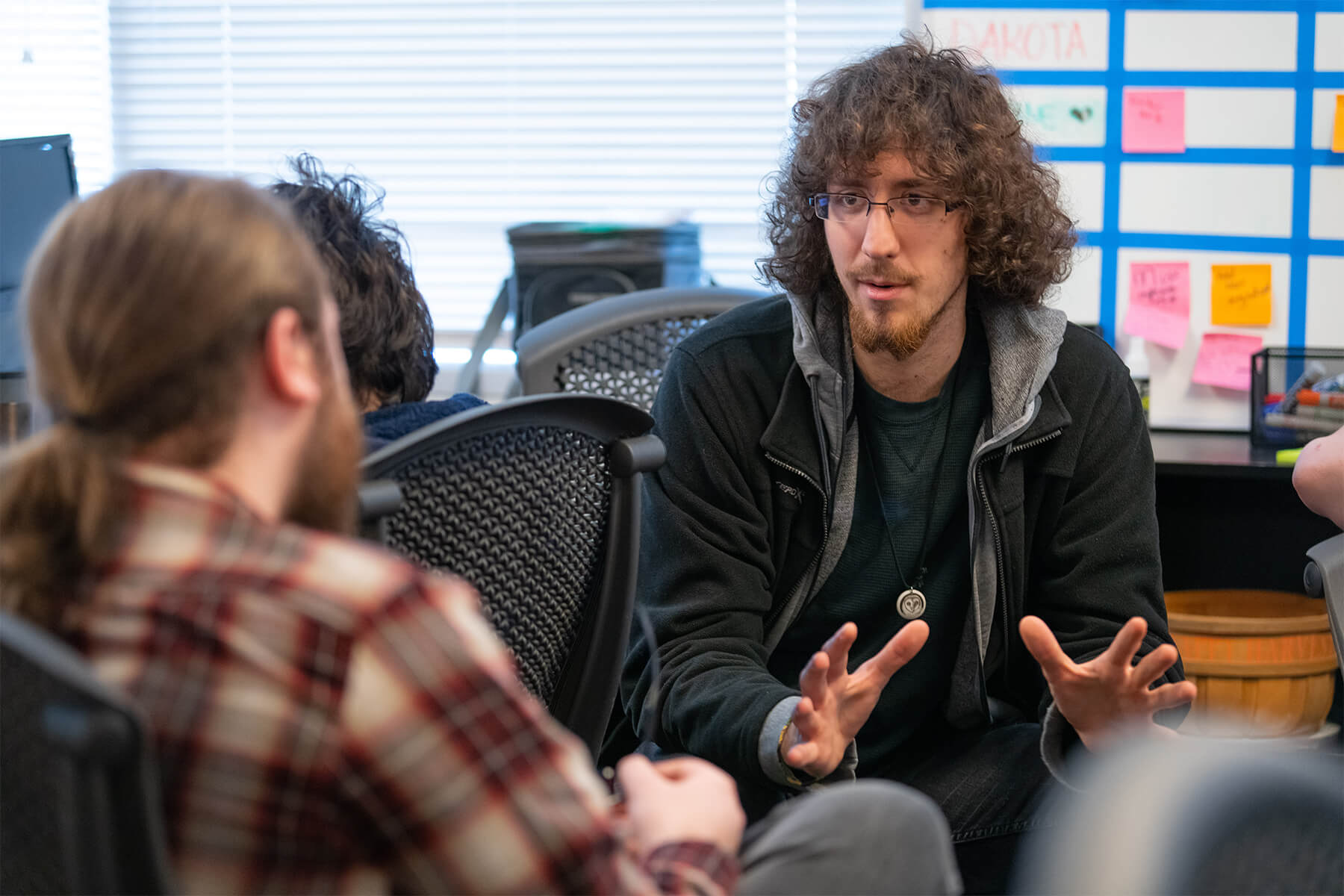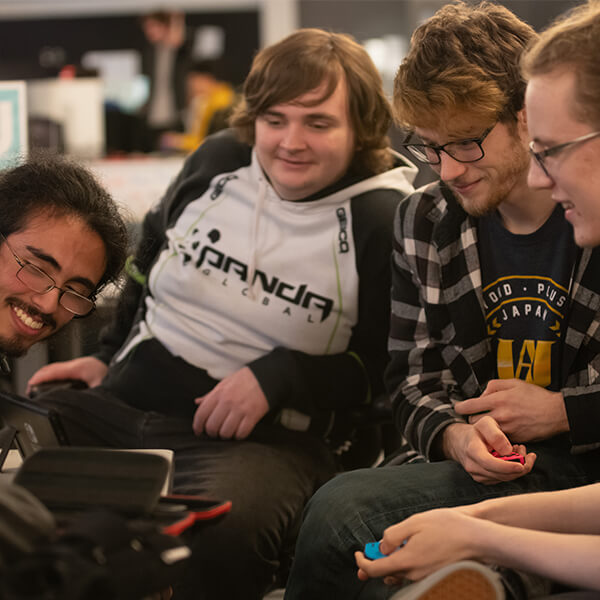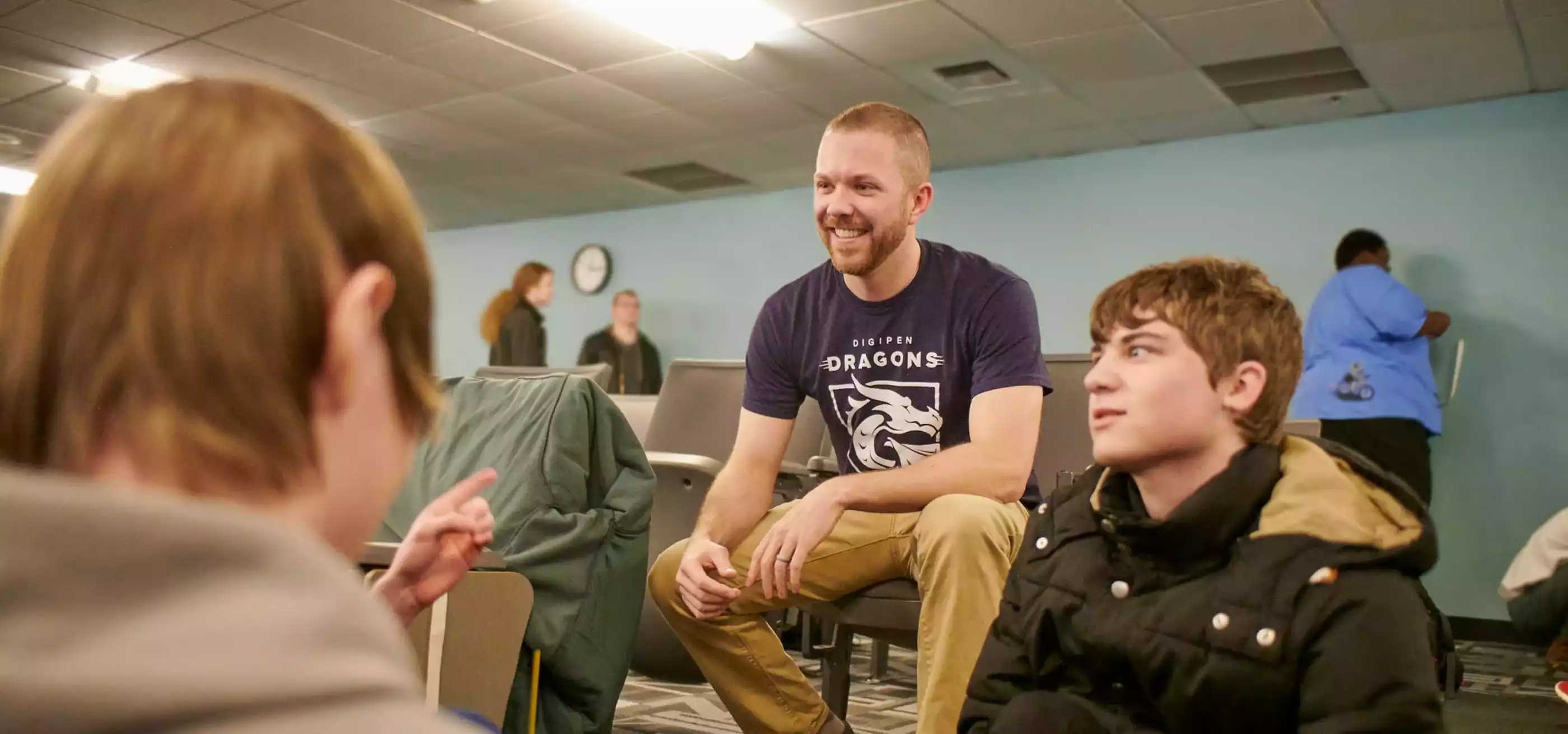Article updated on November 10, 2025.
Working on multidisciplinary, collaborative game team projects is a cornerstone of all four years of a DigiPen education. Read on for a breakdown of freshman year game projects.
Game team projects start out small in scope and size. For one, only students in DigiPen’s computer science programs and BA in Game Design program craft game projects their freshman year — in GAM 100/150 and GAM 120, respectively.
“The most important thing you can take away from GAM 100 and GAM 150 is a love of problem solving,” says freshman computer science game project instructor Justin Chambers. “It may be people problems or code problems, but there is no recipe for making a game. You have a handful of tools and some best practices, but then you just have to experiment, see what works, and solve problems in new and clever ways.”
Design students, meanwhile, have a slightly different aim in GAM 120. “For designers, everything is about the why of what makes something fun,” says BA in Game Design program director Jeremy Holcomb. “We want you to be able to build something together as a team and give us answers about the why in the design decisions you make. Why add a double jump? Why will the player know what to do? What do you want the player to feel?”
Freshman computer science students learn to make games using the C programming language, creating everything but a small pre-provided graphics library from scratch. Rather than making one large, year-long game project like students do in subsequent years, freshmen computer science students make a number of small game projects of varying size. During the first half of the fall semester in GAM 100, students create a series of simple games as individual assignments. In the second half, they collaborate on a three-person team project. Then in the spring, during GAM 150, students form five-person teams and collaborate the entire semester on a single game project.
You have a handful of tools and some best practices, but then you just have to experiment.
“We do icebreakers and get-to-know-you activities during the first half of the semester that help students find potential teammates, and then the team forming is all very organic,” says Chambers. “Short projects and small teams early on allow students the space to make mistakes but recover quickly. You can learn from those experiences and then jump into a new team and project with new perspective and excitement.”
Computer science teams begin by pitching their game ideas to instructors and teaching assistants, who help adjust those ideas to a reasonable scope. Then they create a prototype, presenting their first working code to the class to get helpful early feedback. The first playable build is presented next — just enough to show a single level or puzzle — so that teams can begin playtesting and receiving outside feedback. Finally, teams celebrate their completed projects in a show and tell.

By the time BA in Game Design students take GAM 120, a second-semester freshman year course, they will have taken classes in basic computer science and worked with a game engine. “Your first semester, you learn the skills that give you the framework and tools to build something solo,” Holcomb says. “The second semester, with GAM 120, you have to learn how to build something as a team, which is a totally different skillset! It’s not about you having a good idea, it’s about us having good ideas. It’s no longer, ‘What do I have the skills to build?’ It’s, ‘What elements of my skills are most relevant to my team and what we’re building?’”
Like computer science students, designers may spend the early part of GAM 120 creating small solo game projects before joining their larger team project. But rather than building their game engines from scratch, designers create their projects in a commercial game engine like Unity. “By the end, we want you to know how to have a plan, how to iterate on that plan, and how to test that plan,” Holcomb says. “We also want you to learn how to have ideas you’re passionate about — but also recognize you might be wrong sometimes — and how to share control over your ideas with teammates.”
In GAM 120, teams typically consist of three designers who work together to create a simple, single-player, 2D game of their choosing, usually around five minutes long. Students are given lots of freedom and autonomy in choosing a game idea as long as it stays within a reasonable scope. “What we’re looking for isn’t about what you’re building. It’s all about how you’re building it,” Holcomb says. “We want to see week by week that what you did made the project better, and that you interfaced with the rest of the team to keep the whole project pointing in the same direction.”
Given that the games are built in commercial engines, freshman design student projects have lots of potential for sophistication despite being first-year attempts. “Some of them are on Steam! They’re that good,” Holcomb says. “That’s not the bar we set, but there are plenty of students who graduate and put their GAM 120 games in their portfolio. Really, as long as you show up, turn in your assignments, and are passionate about that why element, it’s very hard not to pass.”
Even though all the students think the classes are about making games, much of the learning actually just comes from forming teams and working with others.
For computer science students, rather than receiving a letter grade on freshman game projects, GAM 100 and 150 are both pass/fail classes. “You don’t need to have a fun game to pass GAM 100 or GAM 150,” Chambers says. “You can have a really rough game but still learn a lot along the way. What matters most is that you just show up and engage.”
That space to engage extends to the division of labor as well. Since all the students creating freshman computer science game projects are programmers, roles within teams tend to be much more fluid. “Everyone has to write code for the game, but there are lots of other things to do such as design, art, and audio,” Chambers says. “No computer science discipline takes the lead on anything in first-year project classes — we actually encourage everyone to try different roles.” The room for experimentation allows students to find early strengths and interests within the game development process, as well as face inevitable programming challenges without undue pressure.
Although the BA in Game Design program is built around six specialization tracks, roles on GAM 120 teams are similarly fluid. “At the freshman level, students may feel like they’re called to one track or the other, but we actually think it’s a good opportunity for exploration,” Holcomb says. “The rubric doesn’t reward you for excelling in certain design tracks. It rewards you for working on a team to create something.”
In the end, freshman year projects are less about the games themselves and more about the process along the way. “Even though all the students think the classes are about making games, much of the learning actually just comes from forming teams and working with others,” Chambers says.
Related articles in this series

Next Article
